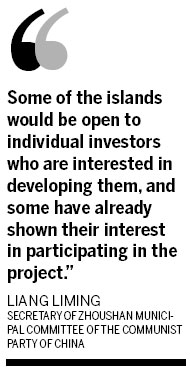Zhejiang looks to islands to boost its economic growth
|
|
|
Under the direction of a local policeman, a public bus drives on to Dachendao island, off Taizhou city, in East China's Zhejiang province. Zhejiang's 12th Five-Year Plan (2011-2015) showed that the province aims to generate more than 720 billion yuan ($116 billion) in gross ocean product by the end of 2015. [China Daily] |
When Zhejiang, the country's entrepreneurial powerhouse, announced it was boosting its marine economy this year, it stirred up enthusiasm for developing the province's thousands of uninhabited islands.
The State Council, the country's cabinet, in early March approved Zhejiang's plan to build a marine economic development zone in the province and urged the province to make the offshore economy an important element of the country's eastern coastal region.
The move is seen as critical for the coastal manufacturing province and its cities, which are struggling in the face of shrinking foreign demand for their products. Now, the province's abundant offshore resources have become a potential strong growth engine for the region.
Zhejiang is one of the country's smallest provinces. It covers an area of 101,800 square kilometers. However, the area of sea within its jurisdiction is 260,000 sq km, according to the local government.
"Our province has a big potential for the development of the marine economy," said Zhao Hongzhu, Party secretary of Zhejiang province, speaking at the National People's Congress session last month.
The province's 12th Five-Year Plan (2011-2015) showed that Zhejiang aims to reach more than 720 billion yuan ($116 billion) in gross ocean product (GOP) by the end of 2015 to make up 15 percent of the country's total by then.
GOP is a part of gross domestic product and reflects development of ocean-related industries, including oil and gas production, fisheries, tourism and maritime transport.
The province's gross ocean product reached 300.2 billion yuan in 2009 to account for 10 percent of the country's total.
In accordance with its offshore economic development scheme, the eastern province has also decided to lift the ban on exploring the several thousands of uninhabited islands for commercial use.
Zhejiang has 3,061 islands of more than 500 square meters in size, with the majority being inhabited.
"We plan to select up to 10 deserted islands in the first phase of the development trial," Liang Liming, Party secretary of Zhoushan, told China Daily.
Zhoushan, located in the coastal area of eastern Zhejiang, consists of 1,390 islands of all sizes with 1,250 of them uninhabited. The city's main island is the fourth biggest in the country.

The city plans to generate 260 billion yuan in ocean economic output by the end of 2015, while the added value of the marine economy is aimed at reaching 86 billion yuan to account for 72 percent of the city's gross domestic product by then.
Liang said that the local government plans to spend 350 billion yuan on the related infrastructure construction for developing the islands during the 12th Five-Year Plan period. About 50 billion was invested in offshore infrastructure development last year.
Liang said Zhoushan authorities are still studying the detailed development plan for the uninhabited islands, part of which may be used for advanced manufacturing and leisure resorts.
"Some of the islands would be open to individual investors who are interested in developing them, and some have already shown their interest in participating in the project," she said.
In addition, Taizhou, another island-rich city in Zhejiang province, is vying with Zhoushan for attracting investors to develop the city's more than 500 uninhabited islands.
"We're planning to develop some of the islands based on functions such as leisure or ecological use," said Chen Tiexiong, Party secretary of Taizhou.
At present, only a general investigation of these islands is being conducted and there is as yet no timetable for development, Chen said.
 0
0 



![Under the direction of a local policeman, a public bus drives on to Dachendao island, off Taizhou city, in East China's Zhejiang province. Zhejiang's 12th Five-Year Plan (2011-2015) showed that the province aims to generate more than 720 billion yuan ($116 billion) in gross ocean product by the end of 2015. [China Daily] Under the direction of a local policeman, a public bus drives on to Dachendao island, off Taizhou city, in East China's Zhejiang province. Zhejiang's 12th Five-Year Plan (2011-2015) showed that the province aims to generate more than 720 billion yuan ($116 billion) in gross ocean product by the end of 2015. [China Daily]](http://images.china.cn/attachement/jpg/site1007/20110425/0011111fa1560f1f1b4208.jpg)



